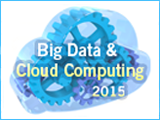IMDEA Networks

Event Category: In-house Presentation
Accessing Resources in (city-wide) Networked Environments: Issues and alternatives
Access to a common (communication) resource has been one of the fundamental problems in the various networking technologies that have emerged over the last half a century.
Seguir leyendo arrow_right_altSéptimo Taller de Trabajo Anual de IMDEA Networks: Big Data y Cloud Computing
Los datos masivos o datos a gran escala (Big Data) y la computación en la nube (Cloud Computing) son dos paradigmas que están evolucionando codo con codo y revolucionando como vivimos y trabajamos. La cantidad de datos que se genera en el mundo aumenta cada día, y no hay indicios de que esta tendencia se vaya a detener a corto plazo (o nunca).
Seguir leyendo arrow_right_altAdopting Software-Defined Networking: Challenges and Recent Developments
Traditional network management only allows to deploy a predefined set of management policies whose parameters can be adapted to specific...
Seguir leyendo arrow_right_altFIB Efficiency in Distributed Platforms
The Internet routing ecosystem is facing substantial scalability challenges due to continuous, significant growth of the state represented in the data plane.
Seguir leyendo arrow_right_alt2nd IMDEA Networks Annual International Workshop: Energy Efficiency and Networking
IMDEA Networks is organizing its 2nd Annual International Workshop, this year focusing on Energy Efficiency and Networking on 31st May - 1st June, 2010 in Madrid, Spain. The workshop will include presentations and a panel dealing with the latest advances and challenges facing the field. Energy efficiency is becoming one of the most important issues of our time. Population growth and exhaustion of available energy sources makes clever use of energy one of the main challenges for our society. The objective of this workshop is to explore the role of networking in the general effort towards sustainable use of energy.
Seguir leyendo arrow_right_alt4th IMDEA Networks Annual International Workshop: Data
Institute IMDEA Networks annually holds a by-invitation-only thematic workshop in Madrid. The workshop accompanies a meeting of our Scientific Council comprised by prominent researchers. In addition to talks by Scientific Council members, the workshop includes invited talks by external experts in the research theme of the workshop. The goal of the 2012 workshop is to foster discussion on a critical aspect of research in networking: data.
Seguir leyendo arrow_right_altTraining Course: 'Detection, Prediction & Monitoring on Online Social Networks: leaders, trends and outliers'
Social scientist have traditionally had limited access to data about individuals, like their personality, relationships or tastes. The widespread use of Online Social Networks (OSNs) has changed this drastically, since OSNs provide huge amounts of data to work with.
Seguir leyendo arrow_right_altThe ICSI Haystack: A Tool to Illuminate the Dark Side of the Mobile Ecosystem
As a society we have come to rely upon our mobile phones for myriad daily tasks. It is striking how...
Seguir leyendo arrow_right_altI Always Feel Like Somebody’s Watching Me. Measuring Online Behavioral Advertising
Online Behavioral targeted Advertising (OBA) has risen in prominence as a method to increase the effectiveness of online advertising. OBA operates by associating tags or labels to users based on their online activity and then using these labels to target them.
Seguir leyendo arrow_right_altSteering with Eyes Closed: Millimeter Wave Beam Steering without In-Band Measurement
Spectrum scarcity and ever increasing densities of wireless network deployments have recently led to an opening of the 60 GHz millimeter-wave bands for unlicensed communication. In contrast to the previously used ISM bands below 5 GHz, a massive amount of 6-9 GHz of bandwidth is available at these frequencies. Usage of these resources is considered for wireless LAN and 5G cellular networks and with the ratification of the IEEE 802.11ad standard in December 2012, wireless LAN is about to bring millimeter-wave communication to the commercial market.
Seguir leyendo arrow_right_alt











Comentarios recientes